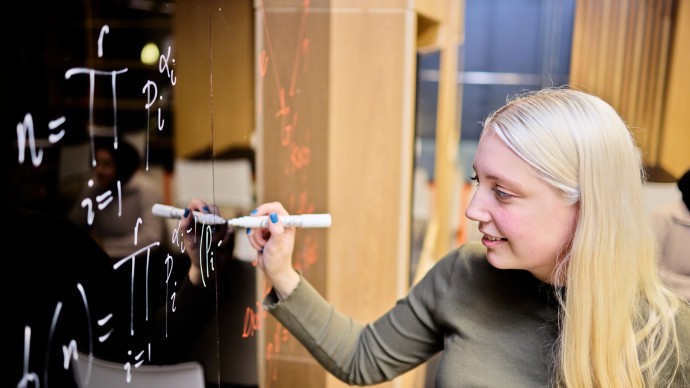Assessing group work
Fair and equitable assessment
As with other types of assessment, when assessing students engaged in group work, the following principle from section 5 of Manchester Met’s Curriculum and Assessment Framework for Taught Programmes needs to be followed: Assessment processes are equitable with all students being assessed fairly on their own individual merit and ability.
Common assessment tasks

Group work assessments can test different kinds of outcomes from individual assignments and so different types of tasks are normally used. Assessment tasks which are commonly used for group work include:
- Presentation
- Poster
- Debate
- Report
- Exhibition
- Performance
- Event organisation
Assessing the skills (group work processes) as well as the outcome
If it is a programme aim that students should work in groups, then you should think about assessing this skill explicitly. In other words, you may wish to assess the process of arriving at the final outcome as well as the outcome itself.
The University of Melbourne suggests that some or all of the following might be assessed:
- Regular meeting attendance.
- Equity of contribution.
- Evidence of cooperative behaviour.
- Appropriate time and task management.
- Application of creative problem solving.
- Use of a range of working methods.
- Appropriate level of engagement with task.
- Development of professional competencies.
- Evidence of capacity to listen.
- Responsiveness to feedback/criticism.
To decide how you might assess any such elements within the assignment, you will need to look at the unit and programme learning outcomes, and at any standard assessment criteria for the programme.

Allocating marks
This is an area where students often feel badly treated with many variations on the theme of “I did all the work and [ so and so ] did nothing and got the same grade as me” appearing in evaluations of group work. Also, group assessment can cause anxiety for students, especially if it counts significantly to the final degree classification (Forsyth and Marr, 2011, p.96).
Remember the principle at the beginning of this section and consider options and relevant factors as follows. Figure 1 below shows the options for allocating marks for group work:
| Tend to assess the group as a whole | Sharing a proportion of the total available mark |
Sharing a proportion of the total available mark, with emphasis on individual |
Tend to have individual assessment of the group members |
|---|---|---|---|
| Sharing the same mark equally between all members of the group |
Sharing a proportion of the total available mark equally and allocating the remainder according to the group’s perception of individual contributions to the task |
Sharing a proportion of the total available mark equally and allocating the remainder for an individual submission which might reflect on the process of completing the group task |
Asking for individual submissions related to the task and marking these rather than marking a group submission |
(Forsyth and Marr, 2011, p.96)
References
Marr, L. and Forsyth, R. (2010). Identity Crisis: Working in HE in the 21st century. Stoke on Trent, Trentham Books
Factors to consider when planning assessment
The selection of the best approach is based on a variety of considerations. For example, if this is the main task for a 30 credit final year unit, the groups are of mixed ability and the students are unfamiliar with group-work processes, then sharing a mark equally between everyone in the group will trouble the students and could distract them from a focus on the tasks and activities required. Figure 2 below indicates factors which might be used to determine the assessment strategy.
| Tend to assess the group as a whole | Sharing a proportion of the total available mark |
Sharing a proportion of the total available mark, with emphasis on individual |
Tend to have individual assessment of the group members |
|---|---|---|---|
| Sharing the same mark equally between all members of the group |
Sharing a proportion of the total available mark equally and allocating the remainder according to the group’s perception of individual contributions to the task |
Sharing a proportion of the total available mark equally and allocating the remainder for an individual submission which might reflect on the process of completing the group task |
Asking for individual submissions related to the task and marking these rather than marking a group submission |
(Forsyth and Marr, 2011, p.96)
The useful University of Melbourne guide to group work covers relevant elements of assessing group work including reasons for using this method, common issues and concerns, designing activities which work, weighing up the options and getting started.
Some form of self or peer assessment which contributes to the final mark may help to counter perceived unfairness in a group mark. An example of the implementation of group assessment sheets can be found in Heathfield, M. 1999. These sheets require students to self-assess their contributions to the groups using five indicators:
-
Regular attendance at group meetings.
-
Contribution of ideas for the task.
-
Researching, analysing and preparing material for the task.
-
Contribution to cooperative group processes.
-
Supporting and encouraging group members.
-
Practical contribution to the end product.
References
Heathfield, Mike (1999). Group-based Assessment: an Evaluation of the Use of Assessed Tasks as a Method of Fostering High Quality Learning. Assessment Matters in Higher Education. S. Brown and A. Glasner, SRHE: 132-145.

Independent study resources
Undergraduate degree classification calculator

Undergraduate degree classification calculator
We have worked with the assessment management team to develop an Undergraduate Degree Classification Calculator. Please note this degree calculator should be used for indicative purposes only.Assessment contact
ASSESSMENT CONTACT
If you have further questions about Assessment, please contact Orlagh McCabe. Click on Orlagh’s profile card for more details.


